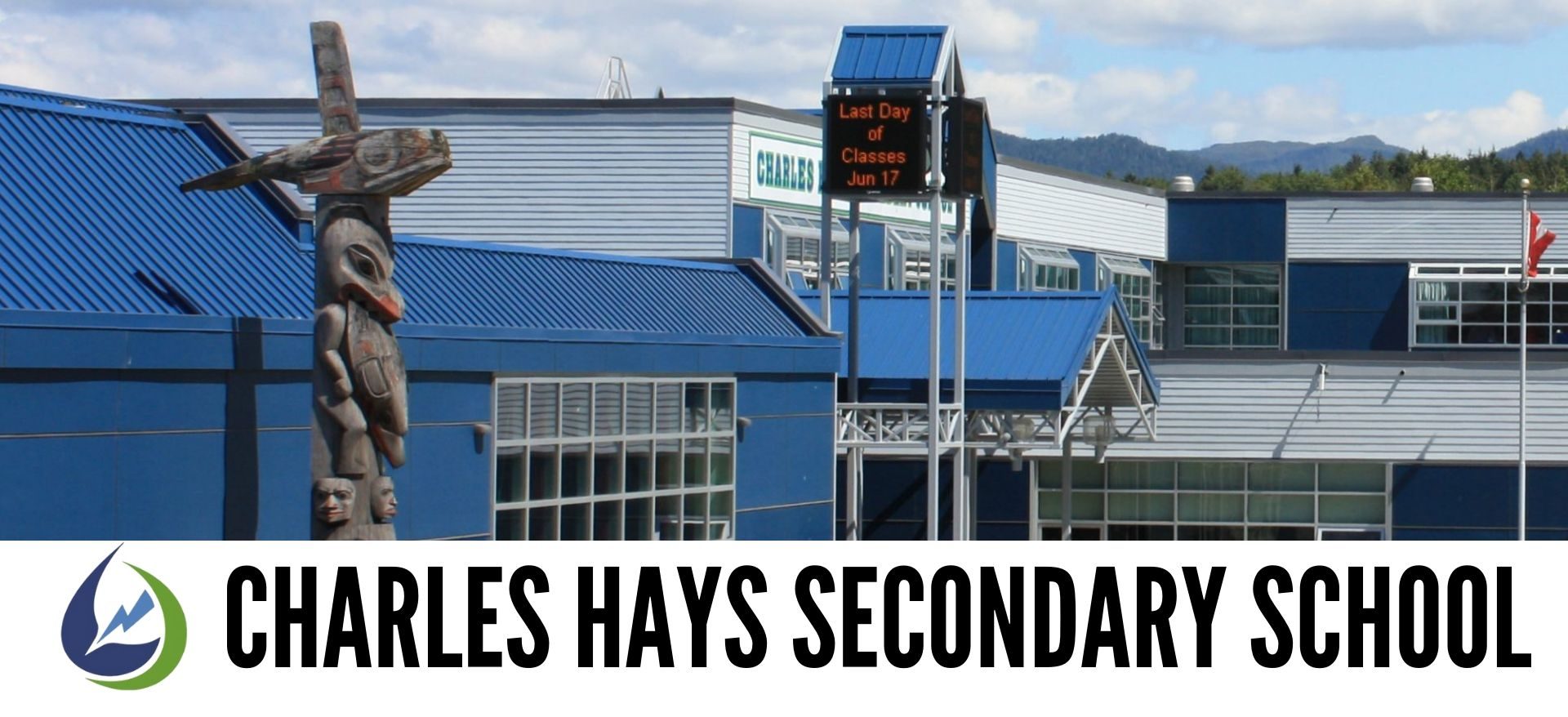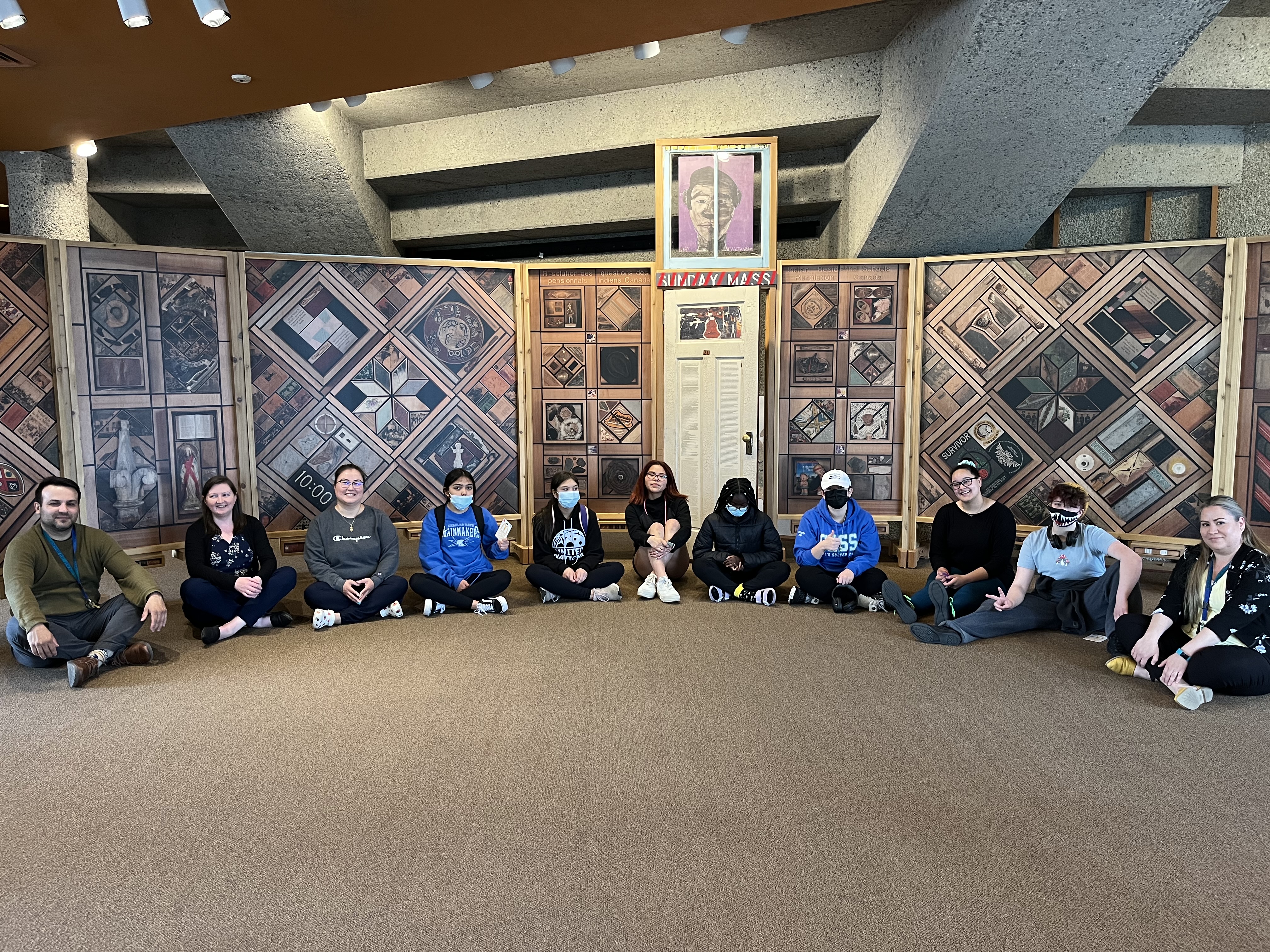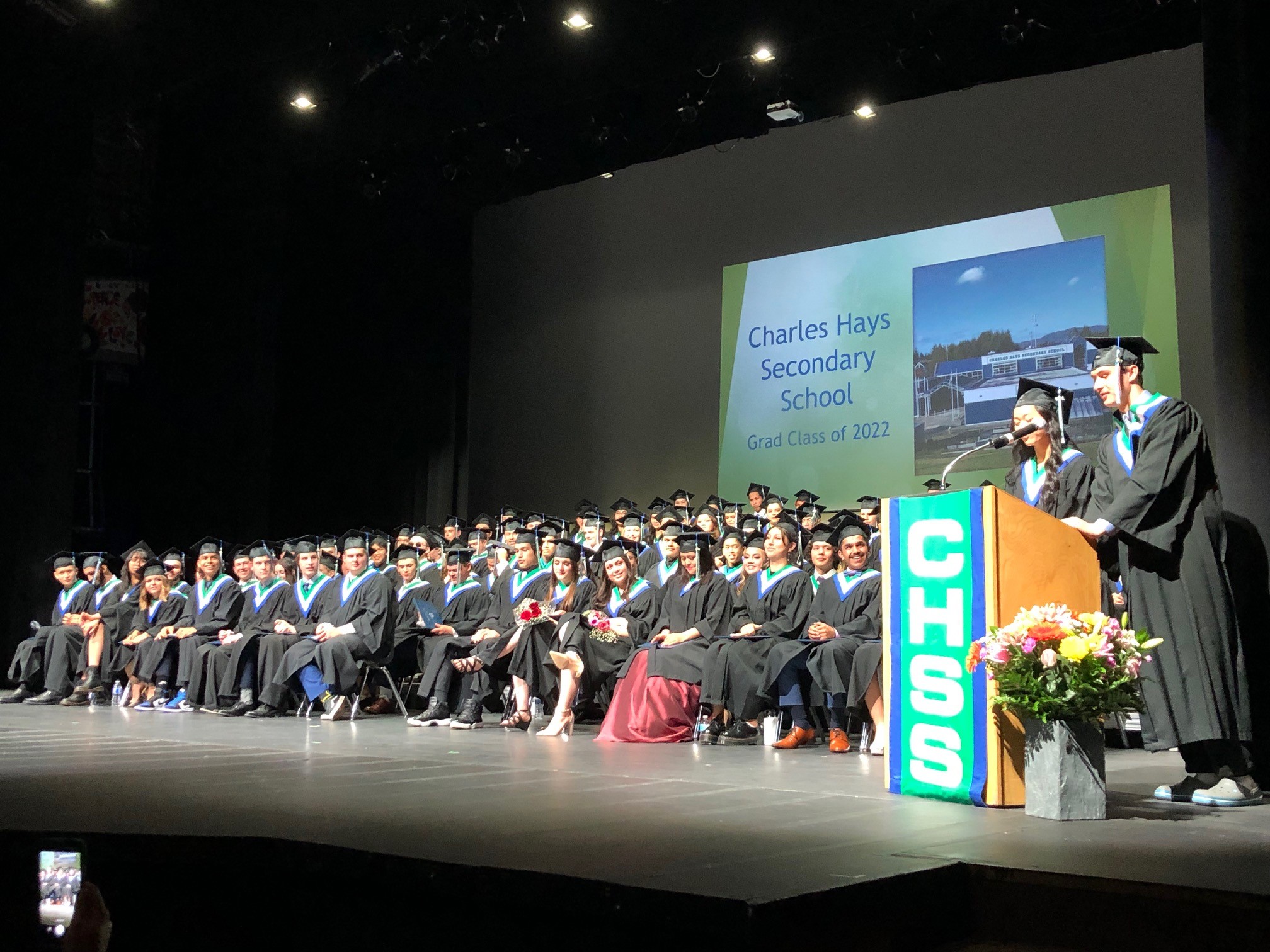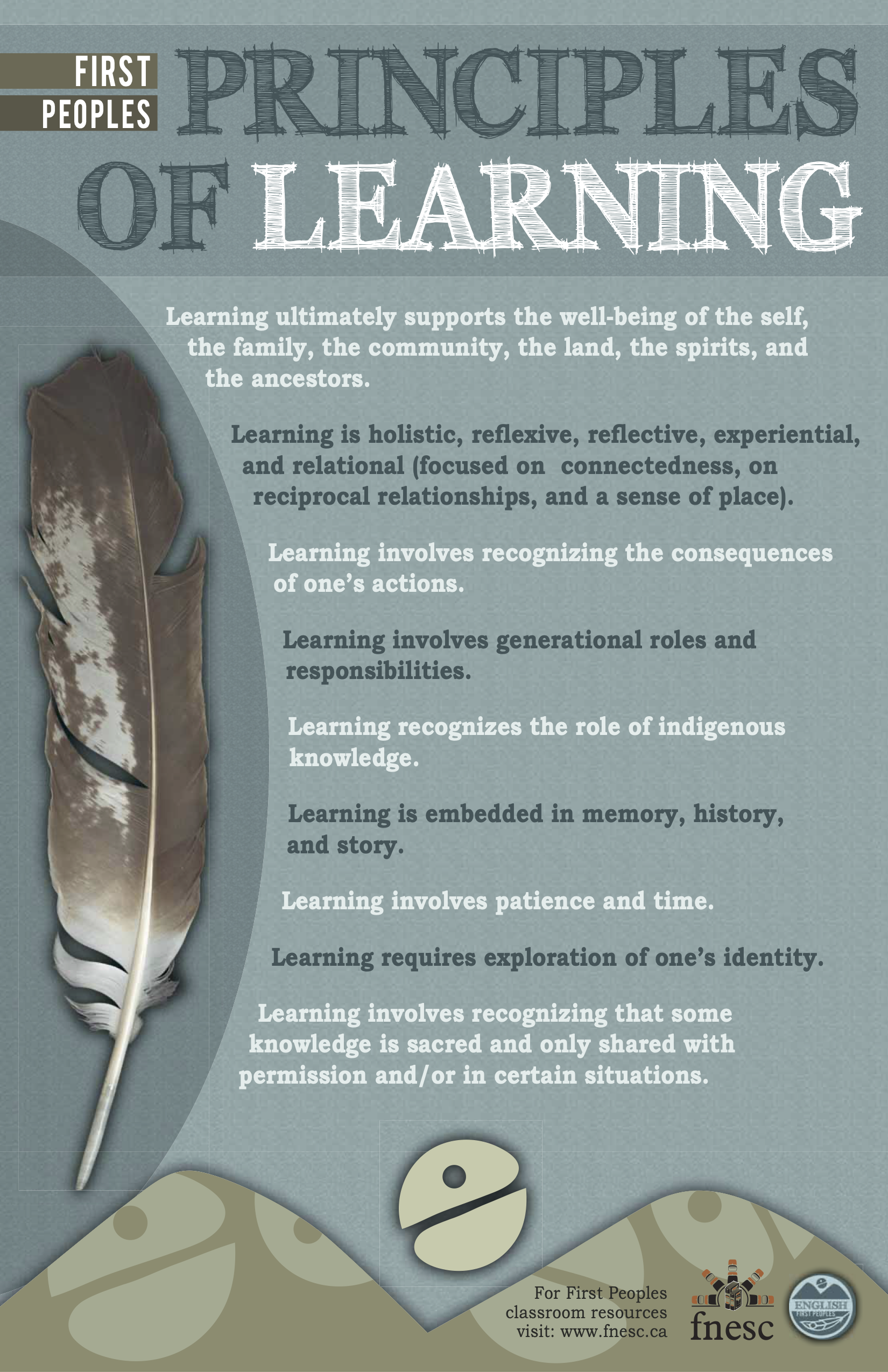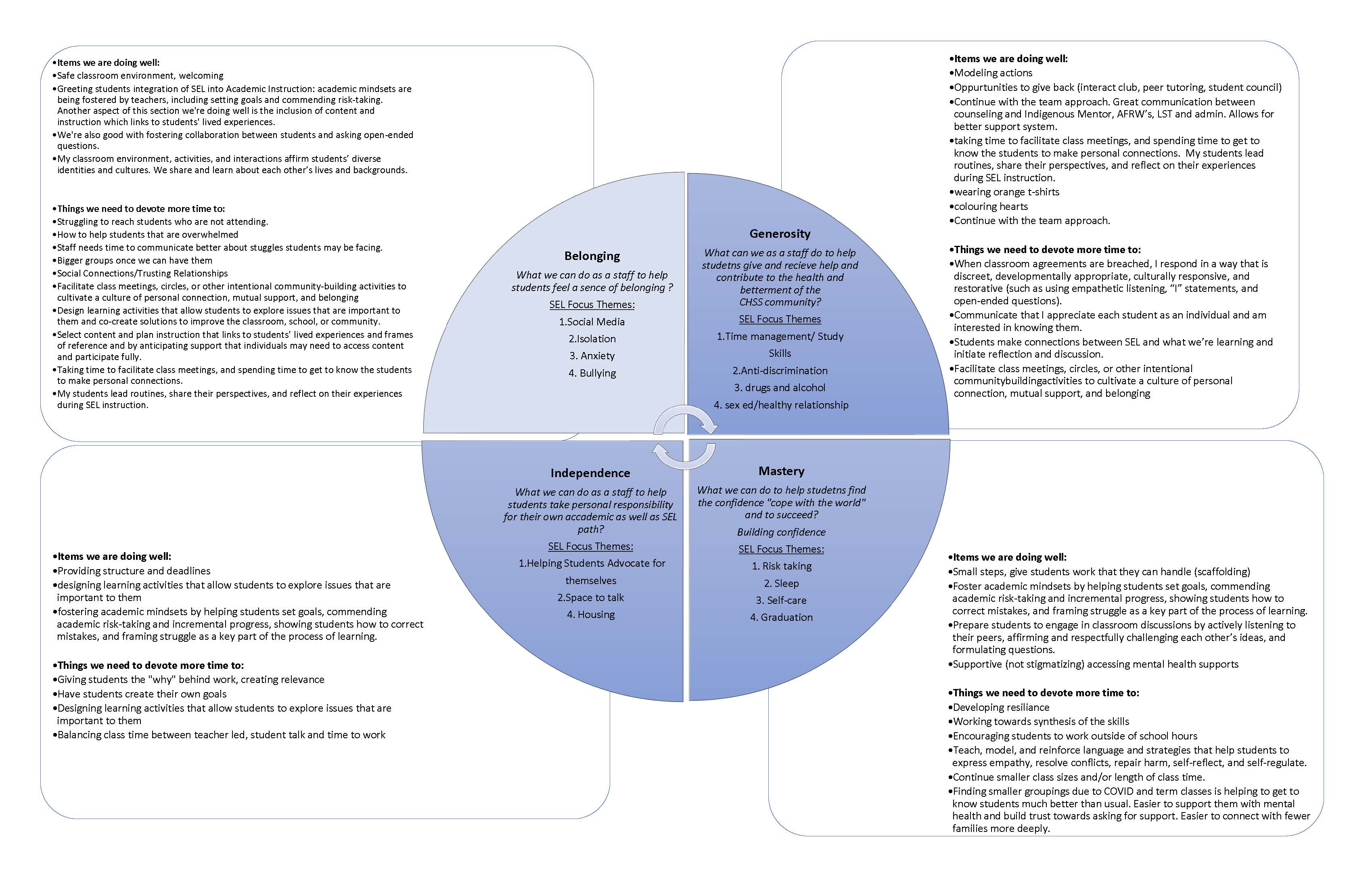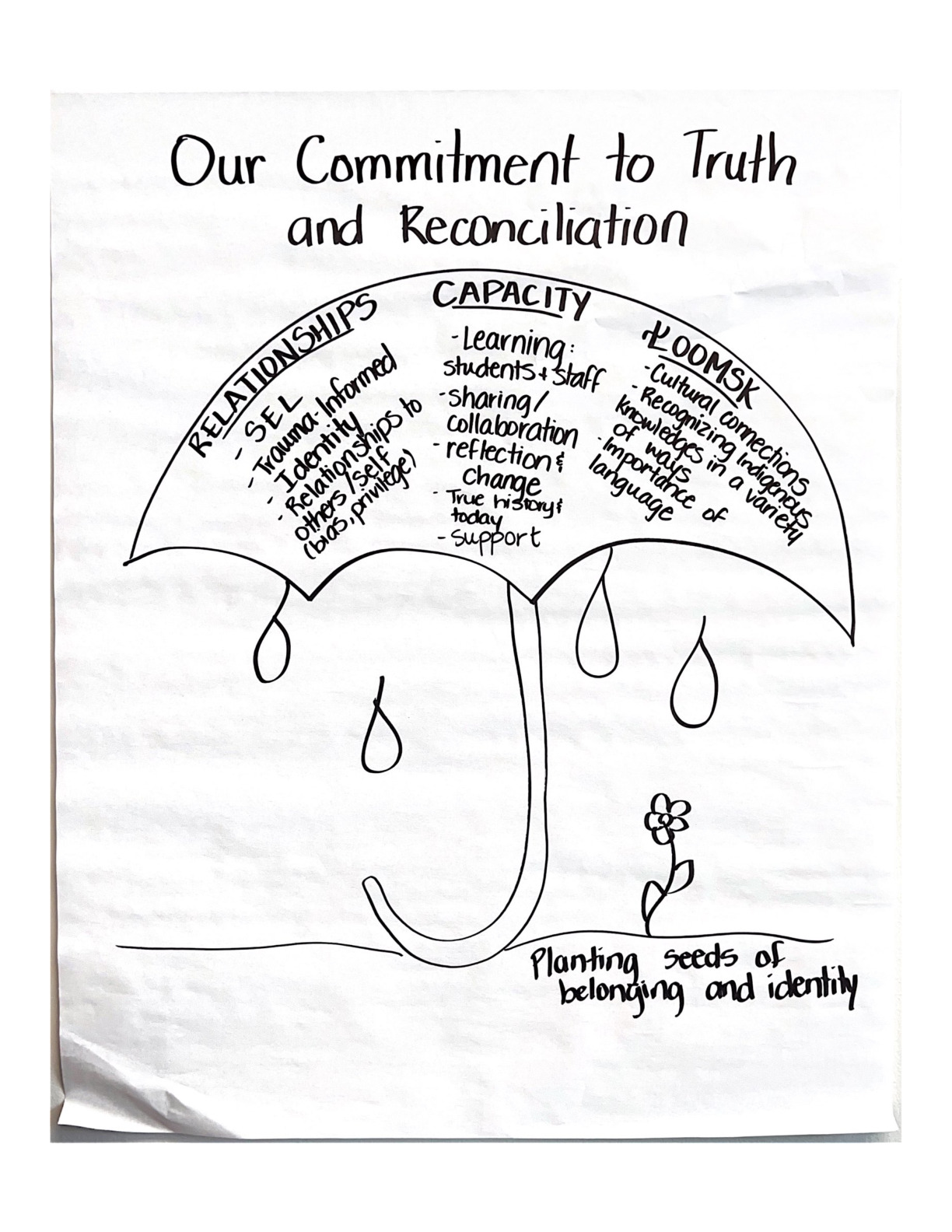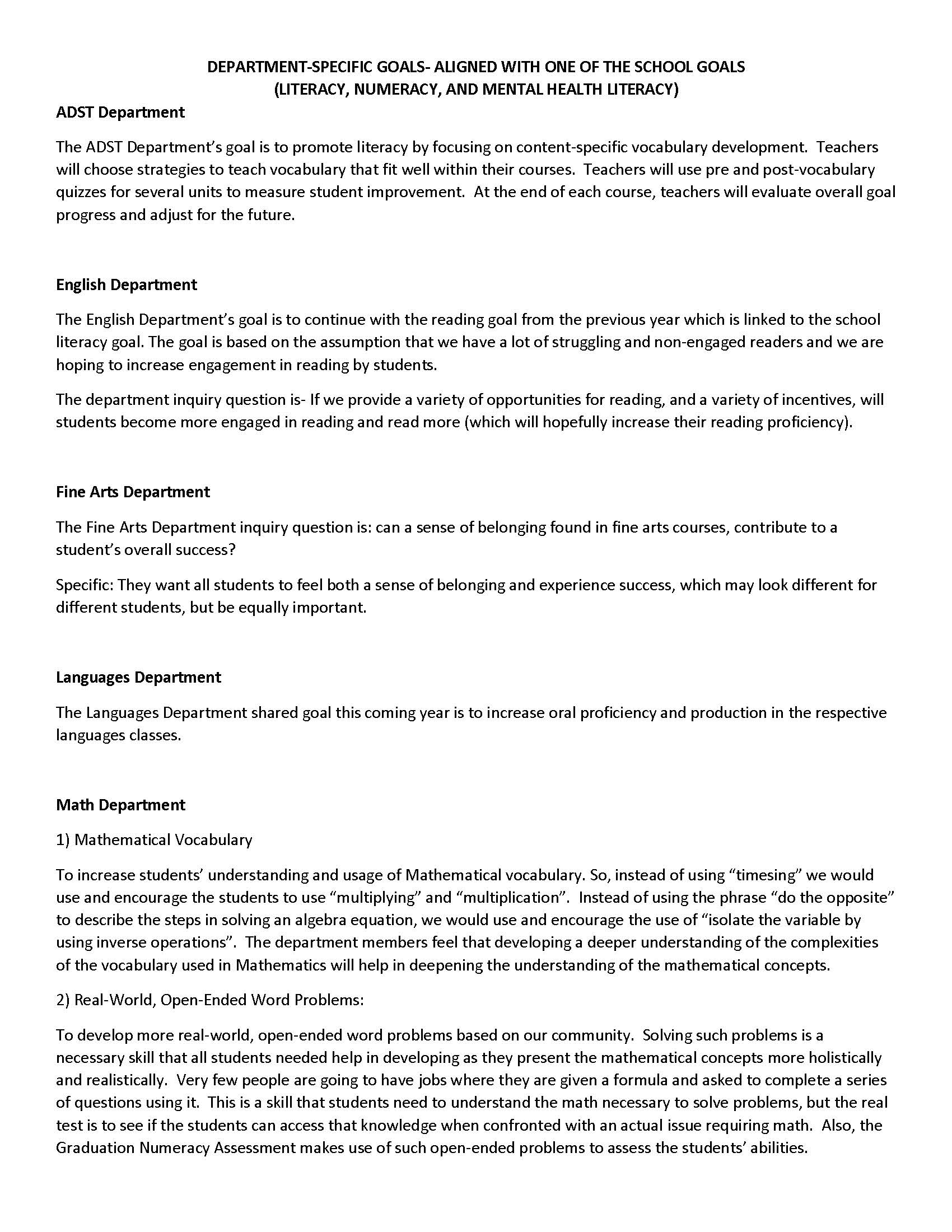![]() CHSS 2022
CHSS 2022
What are the unique, positive characteristics of our school?
CHSS is a dual track school with a French Immersion Program and offers Sm’algyax and French as second language courses. The school has a strong academic program, a growing trades program, a highly competitive sports program, and a vibrant fine arts program.
In 2021/22, we implemented a two classes per day, four terms per year quarter system. For the upcoming 2022/23 school year we will continue with the same system as it allows classes the flexibility to engage in all types of learning opportunities, including learning on the land. We discovered this year, that we enjoy having no bells and unstructured breaks so that breaks can be taken at the best time for the learning in the class. Staff have made strong connections with students right away due to having few transitions between classes, students have reported less stress due to having only two courses at a time to prepare for and students have more opportunities for fresh starts and entry points.
Our staff consists of teachers, education assistants, secretaries, counsellors, fluent language speakers/elders, Indigenous Family Resource Workers, a district careers teacher, and a mentor role to support indigenous students.
What are the important demographics of our school and community?
Charles Hays Secondary School (CHSS) is a grade 9 – 12 high school located in the City of Prince Rupert on the unceded territory of the Ts’msyen and Sm’algyax language speaking peoples, who have been stewards of this land since time immemorial. The school has a diverse multicultural population including 60% students of Indigenous ancestry. Our enrollment has been declining slowly and was approximately 595 students in September 2021.
We are steps away from nature and in our backyard are outdoor learning opportunities that include learning about the local flora and fauna, the history of the territory taught by Indigenous Elders, and experiencing the beauty of Prince Rupert.
We have students with diverse needs and are thankful for the Community Links and Breakfast Club of Canada funding for our Breakfast Club, Lunch Program and After School Art Program.
The majority of CHSS students live in Prince Rupert, we also have students arrive from Metlakatla by ferry and bus and from the village of Port Edward by bus every day.
What do we celebrate?
We have a great deal to celebrate at CHSS including:
- Culturally and socially aware staff and students,
- Sm'algyax language and artwork incorporated into the school and classrooms.
- Strong community partnerships,
- Thriving Sports programs (Basketball, Volleyball, Track, Soccer, Rugby, Wrestling),
- Exceptional Arts programs (Band, Drama, the Musical, Visual Arts)
- A new Library Learning Commons,
- A dynamic greenhouse that produces Farm to Table produce for our Foods Program,
- A delicious Foods Program,
- Sm'algyax and French classes from grades 9-12,
- Transitions Feast to welcome the new grade 8 students to CHSS,
- Excellent shop facilities,
- Basketball Academy,
- Hockey Academy,
- Clubs- Art, Chess, E-Sports, and Book Club,
- Student Council,
- Rotary Interact Club,
- French Immersion,
- PRIDE,
- Youth Explore Trades Sampler and Youth Work in Trades.
What are the strengths and stretches we see in our learners?
Strengths-
- Community oriented,
- Inclusive,
- Respectful,
- Culturally aware,
- Have a strong sense of belonging.
Stretches-
- COVID-19 Learning Loss,
- Social Emotional Resilience,
- Communication,
- Environmental awareness,
- Striving to improve Literacy and Numeracy,
- Attendance and preparedness.
What evidence do we have of these strengths and stretches?
Strengths:
- CHSS students are involved in service clubs such as Student Council and Interact. They embrace local cultural events, donate to charities, and volunteer for with the community.
- Diversity in the school is evidenced by a vibrant and well attended PRIDE celebration and inclusivity in classrooms.
- Participation of students in Focus Group on Anti-Racism
- The majority of classes involved in Truth and Reconciliation learning by visiting the Witness Blanket at the Lester Centre.
- Respectful and culturally aware is evidenced by the Luulgit Learning Feast (welcoming grade 8s to CHSS), Indigenous Day Celebrations, Honouring Indigenous Veterans, learning on the land and from Elders in collaboration with the Indigenous Education Department.
- Belonging is evidenced by our FESL data and student demeanor in our school.
- CHSS connections with Ministry of Child and Family Development Child and Youth Mental Health (CYMH), and Victim Services to collaborate on supporting students in need.
- Connections with Learning Services to co-support students with diverse abilities and disabilities as well as outside organizations such as POPARD.
Stretches:
We had 562 students at the end of the 2021-22. A significant reason for the decline of enrollment from the beginning of the year is students from last years' graduation cohort that did not fully meet graduation requirements came back and completed their programs and graduated.
- We can improve our understanding of environmental stewardship at CHSS by heightening our recycling, using less, composting, littering, and talking more about the environmental impact of climate change.
- Social emotional learning specifically anxiety and stress are concerns for our students and a focus of the next school year's goals.
- Our Literacy assessment data indicates that our student's proficiency level is comparable with the provincial average. However, students have said that they enjoy reading less and this is a priority for next year.
- The Numeracy data indicates that we have more work to do in helping students understand how to apply their math skills to real world problems.
- Attendance and preparedness improved this year with the full day classes. Students seemed to do better with fewer transitions. We are curious how this will translate next year with two classes per day. As a school, we will be focusing on belonging and connection to improve attendance rates.
What areas will we focus on to improve or enhance success for our learners based on what we know about them?
Our overarching goals are Equity, Inclusivity, Mental Health Literacy and Truth and Reconciliation. A primary goal of CHSS is to address systemic barriers impacting Indigenous student achievement. We also strive to ensure that education at CHSS inclusive and accessible to all students.
1) To use the First People's Principles of Learning to guide the education and operation of CHSS.
2) To improve literacy rates.
3) To enhance student application of numeracy.
4) To embed Social Emotional Learning into all interactions within the school community.
What are our specific goals?
Equity
Truth and Reconciliation
Staff Commitment to Truth and Reconciliation:
Our staff commitment to Truth and Reconciliation is built on Relationships, Capacity and łoomsk (respect the land, respect yourself and respect others).
Relationships involve: Social/Emotional Learning; Trauma Informed Practice; Identity; relationships to others and self (bias and privilege)
Capacity involves: professional learning with students and staff; sharing, collaboration; reflection and change; true history today; support.
łoomsk involves: cultural connections; recognizing Indigenous knowledge in a variety of ways; importance of language (the language of the territory Sm'algyax and recognizing problematic colonial language)
Our Goals:
1. Sharing and reviewing Indigenous student data including the Annual District Growth Plan Report and the How Are We Doing Aboriginal Report to make evidence-based decisions regarding school growth. School growth action items will include:
a. Incorporate Sm’algyax into day-to-day greetings, emails, classroom routines, and announcements.
b. Increase and maintain local Indigenous imagery and art on display throughout the school.
c. Celebrate Indigenous culture by recognizing relevant days throughout the school year.
e. Increasing Indigenous student participation in school clubs, teams and student council.
2. Consultation with Indigenous members connected to our school community to:
a. Update code of conduct to include culturally appropriate restorative practice.
b. Increase participation of Indigenous Families in CHSS Parent Advisory Committee.
Literacy
Our school wide goal is to focus on Literacy in each and every class. Each Department is working on a literacy goal that fits the curriculum and unique aspects of their discipline. Collectively, we are working towards a love of reading, increased practice in writing for all subject areas, and the use of explicit literacy strategies to help student access, comprehend, and synthesize written work.
Numeracy
As we reviewed our Numeracy Assessment data, listened to the students' stories, and teacher feedback, we realized that our numeracy goal will be closely tied to our literacy goals. Some students struggle with practical application of math. The action we will take is to utilize more word problems and real world math applications along with literacy strategies to help students decode the relevant information from the extraneous.
Mental Health Literacy
We reflected on our strengths and stretches around Social Emotional Learning at CHSS through three lenses. We brainstormed key themes in the area of SEL that we wanted to prioritize at CHSS. We used a rubric to identify areas we are doing well and areas we would like to devote more time to. Lastly, we used the framework of the Circle of Courage (Belonging, Generosity, Independence, and Mastery) by Martin Brokenleg to organize our thoughts. As we worked through this process we learned that our primary focus next year needs to be in the area of Belonging as this is crucial for success in the other areas. Helping students feel a sense of Belonging at school is also important as we move from COVID-19 restrictions to a more "normal" school year.
What will teachers learn more about to support our goals?
- Bringing in experts and working in departments during Pro-D days and ordering books for a book club type of collaborative learning.
- Make suggestions to the joint Pro-D committee.
- Collaboration around student needs. Resume grade meetings to get a better understanding of individual students needs.
- Implement the literacy and SEL goals intended to address learning loss.
- Support literacy development in classes, such as staff cultivated literacy strategies, building a culture of reading school wide, physical literacy at a younger age to help the continuum through the grades, and French literacy education.
- Professional development in Social Emotional Learning.
What actions/strategies will we take/use (teachers, parents, students, and other stakeholders) to support our goals?
- Student voice and focus groups.
- Partner with Wap Sigagtgyet on authentic resources, protocol, connection to the community, and including Elders, mentors, role models.
- Meetings with parents to brainstorm ways to increase community and family involvement in school.
- Engaging the PAC for feedback and ideas to reach our goals.
- Indigenous Mentor to assist students in the transition from grade 12 to adulthood.
- Transitions course in term one to build relationships and support students to complete courses they missed or need for graduation or transition to the next grade level.
- Continued weekly meetings to track student progress and needs.
- Use data to make evidence based decisions.
What evidence of learning will we collect to check the progress on our goals?
Data from 2021-2022- Please Note the Provincial Data is for the District, not CHSS specific
1) Anecdotal evidence through student voice and staff observations
- The connections between staff and students remained strong under the quarter system.
- Staff and students used the flexibility of having half day classes to engage in field trips, class walks, learning through games, extended science labs, project based learning, and the elective classes thrived.
- Students and staff felt fatigue from the multiple adjustments that came as a results for COVID-19 regulations.
2) Literacy Assessment results
- Our Literacy data is comparable to the Provincial proficiency levels in scores of 3 out of 4.
- We intend as a staff to set small school wide measurable goals that we can track throughout the year for effectiveness.
3) Numeracy Assessment results
- Our Numeracy data demonstrates that we have work to do to achieve the Provincial proficiency levels.
4) Attendance, Honour Roll, and Student Achievement
- We had 109 out of 595 students that achieved excellence in attendance awards this year. There were 7 additional students with perfect attendance.
- There is a strong correlation between the students on the Honour Roll and those who achieve attendance awards.
- There are 182 students who are on the Effort Roll and 137 students who are on the Honour Roll.
- Our average grade this year was 72.2%. Of the students that completed a course, there was an 89.3% success rate.
5) Student achievement and transition rates
- We are noticing a slight improvement in our six year graduation rates. We prefer to look at the six year completion rates as some students need an additional year to complete courses that they need for Post Secondary. COVID-19 is also a factor as some students need the additional year to finish a course or two and address learning loss.
- A key question is why is there a gap between the graduation rates of indigenous and non-indigenous students? How do we close this gap?
- 89% of Indigenous Students and 94% of non-indigenous students are successful when they enter grade 12 with the ability to graduate within that school year.
- 121/142 students graduated this year. Of the 21 students that have not yet graduated, 2 have turned 19 and must finish at the college level, 2 students are returning for an additional transition year as a part of their Individual Education Program, and 17 students will be returning to complete their graduation in 6 years.
- 13 students returned for a partial year to complete their graduation.
6) Surveys including: The Framework for Enhancing Student Learning and The Student Learning Survey
- 83% of our students agree or strongly agree that belong in CHSS.
- 85% of our students feel comfortable at school
- 88% of our students feel that the adults are caring.
- 88% of our students feel that people are available to help with problems.
- More people learning about indigenous culture.
- I respect that I live on unceded territory is very promising. Only 5% disagree
- Learning outside of school has increased
- 44% of our students disagree and strongly disagree that they cope with stress in healthy ways
- 74% of our students do kind things without being asked.
- 63% of our students read for enjoyment, a significant increase from last year.
- 75% of our learners feel hopeful for the future.
I do real calculations with math I learn in school has increased this year.
7) The Aboriginal Report How are We Doing?
- Progress of students entering grade 8 in 2014 is interesting. It shows a significant gap between the indigenous and non-indigenous students' transition rate into grade 12. What this is showing is that the number of indigenous students that take an additional year to graduate is higher than the non-indigenous students. Our main priority is to ensure that everyone graduates whether it is within 5 or 6 years, so we are focused on increasing our 6 year graduation rates first. However, it is a goal to narrow that 5 year gap.
8) Library- We are looking at ways that we can increase a love of reading and get students to read for pleasure. We can track book sign out data from the library in addition to anecdotal evidence from staff.
How will we share our plan with staff?
How will we share our goals with students?
How will we share our goals and progress with parents?
The goals for next year were shared with the Parent Advisory Committee in the June meeting. The full plan will be shared with the PAC in October.
We will be sharing the working school plan on our school website and inviting parents to review it and give feedback. We will also be updating it throughout the year.
